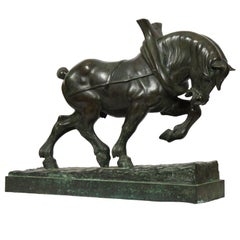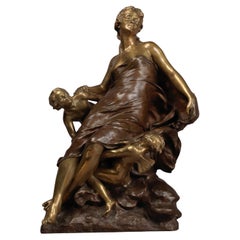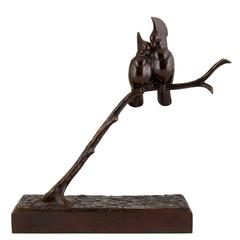Raymond De Meester De Betzenbroeck Furniture
2
to
1
2
2
2
2
1
2
1
1
1
1
1
1
1
2
2
1
5,289
4,012
2,455
2,235
Creator: Raymond De Meester De Betzenbroeck
Terracotta Fish Sculpture by Raymond De Meester, Belgium, 1940s
By Raymond De Meester De Betzenbroeck
Located in Brussels, BE
Terracotta fish sculpture by Raymond de Meester - Belgium, 1940s.
Category
1940s Belgian Mid-Century Modern Vintage Raymond De Meester De Betzenbroeck Furniture
Materials
Terracotta
Important Bronze "Workhorse" by Raymond de Meester
By Raymond De Meester De Betzenbroeck
Located in Altwies, LU
Patinated bronze representing a workhorse in full effort signed on the terrace "Raymond de Meester" (Raymond de Meester de Betzenbroeck 1904-1995)
Baron Raymond de Meester de Betz...
Category
Early 20th Century Belgian Raymond De Meester De Betzenbroeck Furniture
Materials
Bronze
Related Items
1940s Greyhound Sculpture of a Whippet
Located in Dallas, TX
Laying Whippet dog with upright posture molded in composition material.
Category
1940s Vintage Raymond De Meester De Betzenbroeck Furniture
Materials
Composition
'Cupid & Psyche' an Important Bronze Figure by François-Raoul Larche
By François-Raoul Larche
Located in Brighton, West Sussex
'Cupid & Psyche' - An important parcel-gilt and patinated bronze figure, by François-Raoul Larche.
Signed to the base 'Raoul Larche 1891'.
This finely cast parcel-gilt bronze figure depicts Cupid and Psyche with Zephyr.
François-Raoul Larche (1860-1912), the son of an ornamental sculptor, was a well-known Art Nouveau sculptor...
Category
19th Century French Antique Raymond De Meester De Betzenbroeck Furniture
Materials
Bronze
Monumental Important Art Deco Silver & Gilt Bronze Goddess G. Lavaroff
By Georges Lavroff
Located in New York City, NY
An exceptionally large and rare French Art Deco original bronze sculpture circa 1927 by a well known artist Georges Lavaroff (1895-1991)
It's quite uncommon to find this very large size and notably featuring the silver and parcel gilt finish.
The artwork features a majestic female nude, adorned with a stylized cloak in alternating stripes of gold and silver, which showcases a pyramid shape. The Egyptian goddess is depicted as an undraped figure with arms outstretched above her head, holding a crescent moon. She wears a north star headdress that adds to her regal appearance. The cloak is embellished with stars and a comet, and the female figure rests on a bed of stylized clouds. The sculpture is presented on its original black and gold marble base.
All of these attributes add to the uniqueness and value of the artwork, making it even more remarkable and sought after by collectors and art enthusiasts.
Water bottle shown for scale.
Documentation :
Les bronzes Art Deco de Georges Lavaroff, sculpteur Russe a Paris 1930
Kastelyn et Mazzucotelli.
Georges Lavaroff was born in Sibera in 1895. He studied medicine and painting. After the revolution of 1917 he moved to Moscow and became a member of the Russian artists association where he began to exhibit his work and take part in shows as a member of the Association of artists of Revolutionary Russia.
He then worked in France from 1927 until 1935. This period was the richest point of his profession where he produced his most famous works of Art Deco figures...
Category
Early 20th Century French Art Deco Raymond De Meester De Betzenbroeck Furniture
Materials
Gold Plate, Silver Plate, Bronze
H 32.75 in W 22.75 in D 5.75 in
Mid Century Roman Penis Sculpture 1940s
Located in Los Angeles, CA
Introducing a provocative mid-century Roman sculpture from the 1940s - a daring representation of a stone penis encased in a cube of protective glass. This intriguing artwork challen...
Category
1940s Italian Mid-Century Modern Vintage Raymond De Meester De Betzenbroeck Furniture
Materials
Stone
Bronze Sculpture of the Venus de Milo by F. Barbedienne
By F. Barbedienne Foundry
Located in West Palm Beach, FL
This cast bronze sculpture of the Venus de Milo dates to the 1860s-1880s and was cast by the F. Barbedinne foundry in Paris started in 1838 by Ferdinand Barbedienne and Achille Colla...
Category
Late 19th Century French Grand Tour Antique Raymond De Meester De Betzenbroeck Furniture
Materials
Bronze
Terracotta Sculpture by Bent Sørensen
By Bent Sørensen
Located in New York, NY
Terracotta Sculpture by Bent Sørensen, Denmark, circa 1960's.
Category
Mid-20th Century Danish Mid-Century Modern Raymond De Meester De Betzenbroeck Furniture
Materials
Terracotta
Nude Woman Sculpture, Jihokera, 1940s
By Jihokera
Located in Vienna, AT
Jihokera, ceramics, cream-colored cold grading with claw
Excellent original condition with adhesive label.
Category
1940s German Art Deco Vintage Raymond De Meester De Betzenbroeck Furniture
Materials
Porcelain
Important Art Deco Bronze Sculpture, By Claire Jeanne Roberte Colinet
By Claire Colinet
Located in Saverne, Grand Est
Important bronze sculpture with a green-brown patina representing three graces.
The marble may not be original, hence the absence of signature.
Superb qual...
Category
1920s French Art Deco Vintage Raymond De Meester De Betzenbroeck Furniture
Materials
Bronze
H 15.95 in W 24.61 in D 4.73 in
Terracotta Sculpture
Located in Antwerp, BE
Terracotta sculpture signed.
Measures: Height 24 cm.
Width 23 cm.
Depth 12 cm.
Category
Mid-20th Century Belgian Mid-Century Modern Raymond De Meester De Betzenbroeck Furniture
Materials
Terracotta
Rare and important painted bronze Crucifix after a model by Michelangelo
By Michelangelo Buonarroti
Located in Leesburg, VA
A rare and very fine bronze corpus of Christ after a model by Michelangelo, cast ca. 1597-1600 by Juan Bautista Franconio and painted in 1600 by Francisco Pacheco in Seville, Spain.
The present corpus reproduces a model attributed to Michelangelo. The best known example, lesser in quality, is one on display at the Metropolitan Museum of Art (MET).
The association of this corpus with Michelangelo was first brought to light by Manuel Gomez-Moreno (1930-33) who studied the wider circulated casts identified throughout Spain. The attribution to Michelangelo was subsequently followed by John Goldsmith-Phillips (1937) of the MET and again by Michelangelo expert, Charles de Tolnay (1960).
While Michelangelo is best known for his monumental works, there are four documented crucifixes he made. The best known example is the large-scale wooden crucifix for the Church of Santa Maria del Santo Spirito in Florence, made in 1492 as a gift for the Prior, Giovanni di Lap Bicchiellini, for allowing him to study the anatomy of corpses at the hospital there. In 1562, Michelangelo wrote two letters to his nephew, Lionardo, indicating his intention to carve a wooden crucifix for him. In 1563 a letter between Lionardo and the Italian sculptor Tiberio Calcagni, mentions this same crucifix (a sketch of a corpus on the verso of a sheet depicting Michelangelo’s designs for St. Peter’s Basillica [Palais des Beaux-Arts in Lille] may reproduce this). That Michelangelo was working on small corpora in the last years of his life is further evidenced by the small (26.5 cm) unfinished wooden crucifix located at the Casa Buonarroti, considered his last known sculptural undertaking. Michelangelo’s contemporary biographer, Giorgio Vasari additionally cites that Michelangelo, in his later years, made a small crucifix for his friend, Menighella, as a gift.
Surviving sketches also indicate Michelangelo’s study of this subject throughout his career, most notably during the end of his life but also during the 1530s-40s as he deepened his spiritual roots. The occasional cameo of crucified Christ’s throughout his sketched oeuvre have made it challenging for scholars to link such sketches to any documented commissions of importance. All the while, in consideration that such objects were made as gifts, it is unlikely they should be linked with commissions.
Nonetheless, a number of theories concerning Michelangelo’s sketches of Christ crucified have been proposed and some may regard the origin of the present sculpture. It has been suggested that the corpus could have its impetus with Michelangelo’s work on the Medici Chapel, whose exclusive design was given to the master. It is sensible smaller details, like an altar cross, could have fallen under his responsibility (see for example British Museum, Inv. 1859,0625.552). Others have noted the possibility of an unrealized large marble Crucifixion group which never came to fruition but whose marble blocks had been measured according to a sheet at the Casa Buonarroti.
A unique suggestion is that Michelangelo could have made the crucifix for Vittoria Colonna, of whom he was exceedingly fond and with whom he exchanged gifts along with mutual spiritual proclivities. In particular, Vittoria had an interest in the life of St. Bridget, whose vision of Christ closely resembles our sculpture, most notably with Christ’s proper-left leg and foot crossed over his right, an iconography that is incredibly scarce for crucifixes. The suggestion could add sense to Benedetto Varchi’s comment that Michelangelo made a sculpted “nude Christ…he gave to the most divine Marchesa of Pescara (Vittoria Colonna).”
Of that same period, two sketches can be visually linked to our sculpture. Tolnay relates it to a sketch of a Crucified Christ at the Teylers Museum (Inv. A034) of which Paul Joannides comments on its quality as suggestive of preparations for a sculptural work. Joannides also calls attention to a related drawing attributed to Raffaello da Montelupo copying what is believed to be a lost sketch by Michelangelo. Its relationship with our sculpture is apparent. Montelupo, a pupil of Michelangelo’s, returned to Rome to serve him in 1541, assisting with the continued work on the tomb of Pope Julius II, suggesting again an origin for the corpus ca. 1540.
The earliest firm date that can be given to the present corpus is 1574 where it appears as a rather crudely conceived Crucifixion panel, flanked by two mourners in low-relief and integrally cast for use as the bronze tabernacle door to a ciborium now located at the Church of San Lorenzo in Padula. Etched in wax residue on the back of the door is the date, 27 January 1574, indicating the corpus would have at least been available as a model by late 1573.
The Padula tabernacle was completed by Michelangelo’s assistant, Jacopo del Duca and likely has its origins with Michelangelo’s uncompleted tabernacle for the Basilica of St. Mary of the Angels in Rome.
The impetus for the Padula tabernacle’s Crucifixion panel begins with a series of late Crucifixion sketches by Michelangelo, depicting a scene of Christ crucified and flanked by two mourners (see British Museum Inv. 1895.0915.510; Ashmolean Museum Inv. 1846.89, KP II 343 recto; Windsor Castle RCIN 912761 recto; and Louvre Inv. 700). A faintly traced block possibly intended for sculpting the sketch of the crucified Christ on its recto was discovered by Tolnay on a version of the composition at Windsor Castle. The Windsor sketch and those related to it appear to have served as preparatory designs for what was probably intended to become the Basilica of St. Mary’s tabernacle door. Vasari documents that the project was to be designed by Michelangelo and cast by his assistant, Jacopo del Duca. Michelangelo died before the commission was complete, though on 15 March 1565, Jacopo writes to Michelangelo’s nephew stating, “I have started making the bronze tabernacle, depending on the model of his that was in Rome, already almost half complete.” Various circumstances interrupted the completion of the tabernacle, though its concept is later revitalized by Jacopo during preparations to sell a tabernacle, after Michelangelo’s designs, to Spain for Madrid’s El Escorial almost a decade later. The El Escorial tabernacle likewise encountered problems and was aborted but Jacopo successfully sold it shortly thereafter to the Carthusians of Padula.
An etched date, 30 May 1572, along the base of the Padula tabernacle indicates its framework was already cast by then. A 1573 summary of the tabernacle also describes the original format for the door and relief panels, intended to be square in dimension. However, a last minute decision to heighten them was abruptly made during Jacopo’s negotiations to sell the tabernacle to King Phillip II of Spain. Shortly thereafter the commission was aborted. Philippe Malgouyres notes that the Padula tabernacle’s final state is a mixed product of the original design intended for Spain’s El Escorial, recycling various parts that had already been cast and adding new quickly finished elements for its sale to Padula, explaining its unusually discordant quality, particularly as concerns the crudeness of the door and relief panels which were clearly made later (by January 1574).
Apart from his own admission in letters to Spain, it is apparent, however, that Jacopo relied upon his deceased master’s designs while hastily realizing the Padula panels. If Michelangelo had already earlier conceived a crucifix model, and Jacopo had access to that model, its logical he could have hastily employed it for incorporation on the door panel to the tabernacle. It is worth noting some modifications he made to the model, extending Christ’s arms further up in order to fit them into the scale of the panel and further lowering his chin to his chest in order to instill physiognomic congruence. A crude panel of the Deposition also follows after Michelangelo’s late sketches and is likewise known by examples thought to be modifications by Jacopo based upon Michelangelo’s initial sculptural conception (see Malgouyres: La Deposition du Christ de Jacopo del Duca, chef-d’oeuvre posthume de Michel-Ange).
Jacopo’s appropriation of an original model by Michelangelo for more than one relief on the Padula tabernacle adds further indication that the crucifix was not an object unique to Jacopo’s hand, as few scholars have posited, but rather belongs to Michelangelo’s original...
Category
16th Century Renaissance Antique Raymond De Meester De Betzenbroeck Furniture
Materials
Bronze
H 26.25 in W 11.25 in D 4 in
Important Art Deco Bronze Sculpture, By Jean Verschneider
By Jean Verschneider
Located in Saverne, Grand Est
Rare and important large bronze with a green patina with brown nuances representing a young man pulling his chimpanzee by the arm so that it does not grab the two banana hands placed...
Category
20th Century French Art Deco Raymond De Meester De Betzenbroeck Furniture
Materials
Bronze
French Glazed Terracotta Fish Sculpture
By Sarreguemines, Vallauris, Gilbert Metenier, Bitossi, Zsolnay
Located in Houston, TX
French Glazed Terracotta fish sculpture.
Interesting antique French iridescent glazed terracotta fish sculpture. This French fish figure is executed i...
Category
1920s French Art Deco Vintage Raymond De Meester De Betzenbroeck Furniture
Materials
Terracotta
Previously Available Items
Art Deco Bronze sculpture of Two Birds by Raymond de Meester de Betzenbroeck.
By Raymond De Meester De Betzenbroeck
Located in Antwerp, BE
Art deco sculpture of two birds on a branch.
By Raymond de Meester de Betzenbroeck (1904-1995)
Signature/ Marks:
Raymond de Meester
Style:
Art Deco.
Date:
Ca.1935.
Materi...
Category
Mid-20th Century Belgian Art Deco Raymond De Meester De Betzenbroeck Furniture
Materials
Bronze
H 18.51 in W 15.36 in D 4.73 in
Raymond De Meester De Betzenbroeck furniture for sale on 1stDibs.
Raymond De Meester De Betzenbroeck furniture are available for sale on 1stDibs. These distinctive items are frequently made of terracotta and are designed with extraordinary care. There are many options to choose from in our collection of Raymond De Meester De Betzenbroeck furniture, although gold editions of this piece are particularly popular. Many of the original furniture by Raymond De Meester De Betzenbroeck were created in the mid-century modern style in europe during the 20th century. If you’re looking for additional options, many customers also consider furniture by Rogier Vandeweghe, Val Saint Lambert, and Yves Rhayé. Prices for Raymond De Meester De Betzenbroeck furniture can differ depending upon size, time period and other attributes — on 1stDibs, these items begin at $2,405 and can go as high as $5,944, while a piece like these, on average, fetch $4,174.




